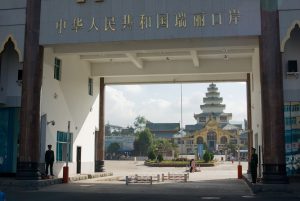A Chinese official yesterday called on Myanmar’s military administration to “cooperate” with China to maintain stability along their common border, amid continued gains by resistance groups in northern Shan State.
The armed offensive launched by the Three Brotherhood Alliance on October 27 has disrupted trade with China and displaced tens of thousands of civilians, some of whom have sought refuge in China.
Nong Rong, assistant Chinese foreign minister, who visited Myanmar on November 3-5, said that he hoped Myanmar would restore stability, and it supported all parties to properly handle differences and achieve reconciliation through dialogue as soon as possible.
“Myanmar is called on to cooperate with China to maintain stability along the China-Myanmar border, earnestly ensure the safety of the lives and property of Chinese border residents, and take effective measures to strengthen the security of Chinese personnel,” said Nong, according to a report by Reuters.
Nong’s comments came after one Chinese citizen was reportedly killed and several others injured when an artillery shell fired by the Myanmar military landed on the Chinese side of the frontier. Its initial target was Laiza in Kachin State, the headquarters of the Kachin Independence Army, around which fighting has raged for weeks.
On October 27, the Three Brotherhood Alliance, which includes the Arakan Army, the Myanmar National Democratic Alliance Army (MNDAA), and the Ta’ang National Liberation Army launched a broad coordinated offensive against Myanmar’s military administration and its allies in the northern part of Shan State.
The Alliance has made rapid progress, with MNDAA claiming as of Saturday to have captured 106 bases and four towns, including Chinshwehaw, an important border crossing with China. The most recent reports indicate that the rebel forces may have since captured Namkham, close to the junction of Shan’s borders with China and Kachin State, and Kunlong, a town on the Salween River to the west of Chinshwehaw. The MNDAA has posted what appear to be photos of its troops standing on the town’s Kunlong New Bridge, a Chinese-funded project that was only inaugurated by the military administration in June.
Last week, Myanmar’s military chief Senior Gen. Min Aung Hlaing said that his junta planned to ” launch counter-attacks” against the Alliance, the state-run Global New Light of Myanmar reported on Friday. But aside from retaliatory airstrikes, a proper counter-offensive has yet to eventuate.
As I’ve noted previously, the offensive and its attendant disruptions have created headaches for Chinese policymakers. Since the capture of Chinshwehaw, trade across the border has ceased, while the attack has also forced the closure of the Ruili-Muse border crossing, the primary conduit of Myanmar’s official trade with China.
The fighting has also disrupted any chance of progress on the construction of the China-Myanmar Economic Corridor (CMEC), an integrative infrastructure scheme that seeks to connect China’s Yunnan province by road and rail to the Indian Ocean. As Jason Tower of the United States Institute of Peace noted yesterday, the MNDAA now controls “the two key Myanmar towns that make up the Lincang-Chinshwehaw-Kunlong Cross Border Economic Cooperation Zone,” one of the many projects included under the CMEC.
Since the beginning of the offensive, the question of how China would respond has loomed large, given its long-standing relations with most of the ethnic rebel groups along its border with Myanmar, and its enhanced leverage over the military regime in Naypyidaw since the disastrous coup of 2021.
So far, things have proceeded largely along the same lines as during previous episodes of conflict along the border, with Chinese officials calling for calm and dialogue aimed at the restoration of the minimal degree of stability necessary to advance China’s core strategic goals. This was more or less the agenda of Chinese Public Security Minister Wang Xiaohong, who was rushed to Naypyidaw for talks with several high-ranking junta leaders, including Min Aung Hlaing, last week.
In an article for The Irrawaddy yesterday, Bertil Lintner, a long-time Myanmar watcher, argued that despite the seemingly rapid changes to the constellations of power in northern Shan State, Beijing’s goal remained the same: “to exploit Myanmar’s natural resources and, most importantly, to secure the so-called China-Myanmar Economic Corridor which gives it strategic access to the Indian Ocean.”
He added, “To achieve those goals, China has always played all sides in Myanmar’s internal conflicts and it is therefore not, it should be remembered, in China’s interest to see the emergence of a strong, peaceful, democratic and federal Myanmar.”

































